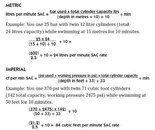Wart, your statements regarding Rock Bottom and the Free Flow scenario indicates you do not really understand the concept of Rock Bottom. Your statement that you have 90 seconds to get to the surface is, quite simply, idiotic since it makes some major assumptions -- perhaps the most important being that one has a full(ish) tank when the free flow occurs. That, of course, is when Rock Bottom is really at its most irrelevant -- is it not?
Thus, the scenario where Rock Bottom becomes important is when one HAS a free flowing (or other misbehaving regulator) at the END of the dive, NOT at the beginning. And when does the dive end? When one reaches Rock Bottom (or before). BUT IF you are at 25 meters, you've been there so that you are AT your minimum air reserves (aka Rock Bottom) and your buddy's reg malfunctions (free flows for whatever reason), would it still be your position that "breathing from a free flowing reg" and ascending is the most appropriate response?
As an instructor, albeit one of those who does this for fun, rather than profit, I try to teach even my open water students that they need to be thinking divers. In addition, one of the things I try to convince them with the "free flowing reg" exercise in confined water is that IF they ever actually have a free flowing reg, to get it away from them! Almost all agree that they CAN breathe from the reg but that it makes much better sense to get that reg away from their bodies and breathe from their backup (Octo).
I would hope that IF any of them actually had this occur, they would have the good sense to go on their buddy's AAS, keep the free flowing reg away from their body and get out of Dodge. One can only do this IF one follows the rules of Rock Bottom.
Wart, do you really teach your students that breathing from a free flowing reg is the best possible solution?
Thus, the scenario where Rock Bottom becomes important is when one HAS a free flowing (or other misbehaving regulator) at the END of the dive, NOT at the beginning. And when does the dive end? When one reaches Rock Bottom (or before). BUT IF you are at 25 meters, you've been there so that you are AT your minimum air reserves (aka Rock Bottom) and your buddy's reg malfunctions (free flows for whatever reason), would it still be your position that "breathing from a free flowing reg" and ascending is the most appropriate response?
As an instructor, albeit one of those who does this for fun, rather than profit, I try to teach even my open water students that they need to be thinking divers. In addition, one of the things I try to convince them with the "free flowing reg" exercise in confined water is that IF they ever actually have a free flowing reg, to get it away from them! Almost all agree that they CAN breathe from the reg but that it makes much better sense to get that reg away from their bodies and breathe from their backup (Octo).
I would hope that IF any of them actually had this occur, they would have the good sense to go on their buddy's AAS, keep the free flowing reg away from their body and get out of Dodge. One can only do this IF one follows the rules of Rock Bottom.
Wart, do you really teach your students that breathing from a free flowing reg is the best possible solution?





